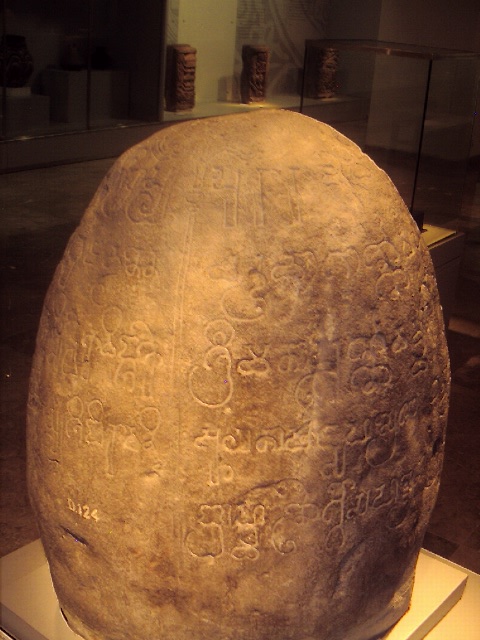Purnawarman on:
[Wikipedia]
[Google]
[Amazon]
 Purnawarman or Purnavarman was the 5th-century king of Tarumanagara, a
Purnawarman or Purnavarman was the 5th-century king of Tarumanagara, a
 Purnawarman or Purnavarman was the 5th-century king of Tarumanagara, a
Purnawarman or Purnavarman was the 5th-century king of Tarumanagara, a Hindu
Hindus (; ; also known as Sanātanīs) are people who religiously adhere to Hinduism, also known by its endonym Sanātana Dharma. Jeffery D. Long (2007), A Vision for Hinduism, IB Tauris, , pp. 35–37 Historically, the term has also be ...
Indianized kingdom, located in modern-day West Java
West Java (, ) is an Indonesian Provinces of Indonesia, province on the western part of the island of Java, with its provincial capital in Bandung. West Java is bordered by the province of Banten and the country's capital region of Jakarta to t ...
, Jakarta
Jakarta (; , Betawi language, Betawi: ''Jakartè''), officially the Special Capital Region of Jakarta (; ''DKI Jakarta'') and formerly known as Batavia, Dutch East Indies, Batavia until 1949, is the capital and largest city of Indonesia and ...
and Banten
Banten (, , Pegon alphabet, Pegon: بنتن) is the westernmost Provinces of Indonesia, province on the island of Java, Indonesia. Its capital city is Serang and its largest city is Tangerang. The province borders West Java and the Special Capi ...
provinces, Indonesia
Indonesia, officially the Republic of Indonesia, is a country in Southeast Asia and Oceania, between the Indian Ocean, Indian and Pacific Ocean, Pacific oceans. Comprising over List of islands of Indonesia, 17,000 islands, including Sumatra, ...
. Purnawarman reigned during the 5th century, and during his reign he created several stone inscriptions.
According to these inscriptions he embarked on a hydraulic project and also identified himself to Vishnu
Vishnu (; , , ), also known as Narayana and Hari, is one of the Hindu deities, principal deities of Hinduism. He is the supreme being within Vaishnavism, one of the major traditions within contemporary Hinduism, and the god of preservation ( ...
, which indicates him and his kingdom were adhering to the Vishnuite faith. King Purnawarman established a new capital city for the kingdom, located somewhere near present-day Tugu (North Jakarta
Jakarta (; , Betawi language, Betawi: ''Jakartè''), officially the Special Capital Region of Jakarta (; ''DKI Jakarta'') and formerly known as Batavia, Dutch East Indies, Batavia until 1949, is the capital and largest city of Indonesia and ...
) or Bekasi.
His name in Sanskrit
Sanskrit (; stem form ; nominal singular , ,) is a classical language belonging to the Indo-Aryan languages, Indo-Aryan branch of the Indo-European languages. It arose in northwest South Asia after its predecessor languages had Trans-cultural ...
means "perfect shield" or "complete protector". Later Tarumanagaran kings are only known from their names, all bear the name ''warman'' (Sanskrit
Sanskrit (; stem form ; nominal singular , ,) is a classical language belonging to the Indo-Aryan languages, Indo-Aryan branch of the Indo-European languages. It arose in northwest South Asia after its predecessor languages had Trans-cultural ...
: ''varman'' means "shield" or "protector") which suggests that all of them belongs to the same dynasty.
Historiography
Purnawarman is the most well known ruler among Tarumanagaran kings, mostly because he extensively created numbers of stone inscriptions, proclaiming his deeds and feats. He left seven memorial stones with inscriptions bearing his name spread across today Jakarta, Banten and West Java provinces. These seven inscriptions areː # Tugu inscription # Ciaruteun inscription # Kebon Kopi inscription #Jambu inscription #Pasir Awi inscription #Muara Cianten inscription # Cidanghiang inscription The Tugu inscription, which is written in Pallava script and is a few years older than the Ciaruteun inscription, is considered the oldest of all the inscriptions. There are more stones with inscriptions from the time of king Purnawarman, some close to Bogor city. They are Muara Cianten, Prasasti Pasir Awi, Cidanghiang, and Jambu inscriptions. Cidanghiang inscription sits further to the west at Lebak in the Pandeglang area, consisting of two lines, proclaiming Purnawarman as the example for rulers around the world. Jambu inscription, with a two-line inscription inPallava
The Pallava dynasty existed from 275 CE to 897 CE, ruling a significant portion of South India, the Deccan, also known as Tondaimandalam. The Pallavas played a crucial role in shaping in particular southern Indian history and heritage. The ...
and Sanskrit
Sanskrit (; stem form ; nominal singular , ,) is a classical language belonging to the Indo-Aryan languages, Indo-Aryan branch of the Indo-European languages. It arose in northwest South Asia after its predecessor languages had Trans-cultural ...
, bears the large footprints of the king. The inscription translates as:
The Wangsakerta manuscript, which experts believe to be a 20th-century forgery, notes in parwa II sarga 3 (page 159 – 162) that under the reign of King Purnawarman, Tarumanagara held control over 48 small kingdoms with area stretching from Salakanagara or Rajatapura to ''Purwalingga'' (current city of Purbalingga in Central Java Province). Traditionally Cipamali river (Brebes river) was the border between Sunda and Java. However, this claim is not reliable because the Wangsakerta manuscript is not an authentic historical source.
References
{{DEFAULTSORT:Purnawarman Indonesian Hindu monarchs Tarumanagara Brahmic scripts 5th-century monarchs in Asia